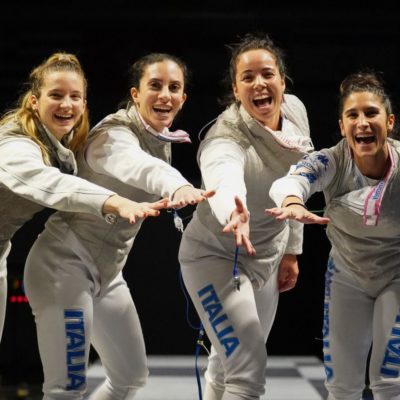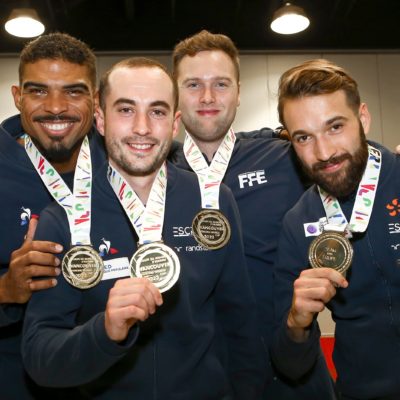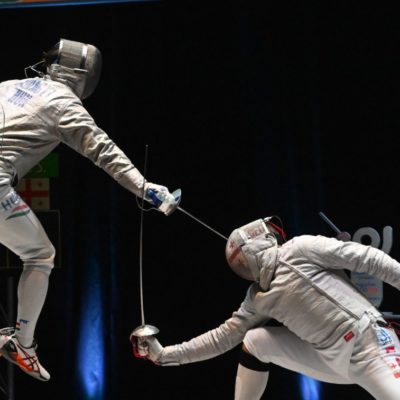Colorado Springs, April 26, 2004 – With the close of Nationals, the United Stated Fencing Association announces the nomination of the Men’s and Women’s Fencing teams that will represent the United States in this year’s Olympic Games. The US is anticipating its strongest team in decades, possibly ever, and this highly talented pool of young fencers will set out to make their mark on both US and Olympic history, while trying to capture the first American fencing medal in twenty years.
“We couldn’t be more excited for our athletes as we head into the Olympic Games with one of our strongest teams ever,” said Michael Massik, Executive Director of the United States Fencing Association. “This is such a great, young group of athletes, I have no doubt they’ll be excellent representatives for the country and this growing sport.”
This year’s US Olympic Fencing team of thirteen athletes is the fourth largest fencing team in the games. The size of the team proves America’s strength in the sport is rapidly growing. Sada Jacobson and Keeth Smart, the only US fencers to ever reach a number one world ranking, will lead a team that is poised for success. This year’s team is also comprised of two sets of siblings in Sada and her younger sister Emily and Smart and his younger sister Erinn.
Olympic fencers participate in one of three weapons: foil, épée, or sabre, and for the first time ever, the United States looks to be strong in all three categories, both men and women. The USFA will nominate the following athletes to the United States Olympic Committee and will then finish the nomination process in May.
Men’s Sabre
The U.S. men’s team will look to make their presence felt in all three of the disciplines and will be led by the twelfth ranked sabre fencer in the world, Keeth Smart (25). Smart, a New York native, became the first American fencer ever to reach a number one world ranking with his silver medal finish in sabre at the Senior “A” World Cup held in March of 2003 in Athens, Greece. Keeth will be joining Ivan Lee (23) and Jason Rogers (20) to create the formidable US men’s sabre team. Ivan, also a New York native, has had a very successful year climbing to a world ranking of 26 while Jason Rogers of Los Angeles, has also enjoyed much success this season ranked 28th in the world.
Men’s Foil
The men’s foil team of Dan Kellner (27, Warren, NJ), Jon Tiomkin (24, New York, NY) and Jed Dupree (24, New York, NY), all products of The Fencers Club in New York, will also have high hopes heading into the Olympic Games. The close knit team possesses the ability and experience to have terrific outings in both the individual and team events. The replacement athlete is Gregory Chang (28, Lexington, MA), a member of the Boston Fencing Club.
Men’s Épée
The men’s épée team will build on the momentum it gained from a fantastic outing at a recent World Cup event in Vancouver, Canada. The team of Cody Mattern (23, Portland, OR), Seth Kelsey (22, Brush Prairie, WA) and Soren Thompson (22, San Diego, CA) finished ninth in the Canadian event securing their place in the Olympics and giving them a great deal of confidence along the way.
On the women’s side, hopes run just as high. The only women’s team event to be held in Athens will be women’s épée, however the US failed to qualify a women’s épée team in this event. Furthermore, there will be no team event for women’s saber and women’s foil. However, the individual female fencers are some of the top in the world and will definitely make their presence felt in Athens.
Women’s Sabre
This will be the first Olympics ever that women’s sabre fencing is competed and sisters Sada (21) and Emily (18) Jacobson, of Atlanta, GA, will be representing the US in its debut. Sada, the world’s top ranked sabre fencer, last year became the first American woman to ever reach a world ranking of number one and, in the process, became the first American, male or female, to be named World Cup champion. With three top ten finishes already this year, Sada’s confidence is high heading into the Games. Emily, the number ten ranked sabre fencer in the world, also has reason to be confident, with two top ten finishes of her own this year.
Women’s Foil & Épée
In two very tight races, Erinn Smart (24, Brooklyn, NY) and Kamara James (19, Jamaica, NY) qualified to represent the US women in foil and épée, respectively. Erinn, the sister of men’s sabre fencer, Keeth Smart, has posted solid finishes throughout 2004 competition while Kamara James builds off her 3rd place finish in February of this year.
Evolved from the ancient form of combat, fencing is one of only four sports to be featured at every modern Olympic Games. Since the first modern Olympics were held in Athens in 1896, the United States has claimed seven individual medals (three silver / four bronze) and five team medals (one silver / four bronze). The last fencing medal the United States won was Peter Westbrook’s bronze medal at the 1984 Olympics in Los Angeles. But fencing’s steady growth in popularity has led to what might be the strongest American contingency ever.
The sport of fencing is fast and athletic, a far cry from the choreographed bouts seen on film or on the stage. Instead of swinging from a chandelier or leaping from balconies, competitive fencers match skills on a six-feet-by-40-feet strip. The movement is so fast the touches are scored electronically – more like Star Wars than Errol Flynn.
A foil is a thrusting sword with a flexible rectangular blade and a small guard. An épée is a thrusting sword descended from the dueling sword, similar in length to a foil but heavier, with a larger guard and a much stiffer blade. Finally, the sabre is the modern version of the slashing cavalry sword, similar in length to the foil but able to cut with the blade as well as hit with the point.
The United States Fencing Association (USFA) is the recognized NGB for the sport of fencing in the United States. The USFA was founded in 1891 as the Amateur Fencers League of America (AFLA) by a group of New York fencers seeking independence from the Amateur Athletic Union. The AFLA changed its name to the United States Fencing Association in 1981.
Share:





